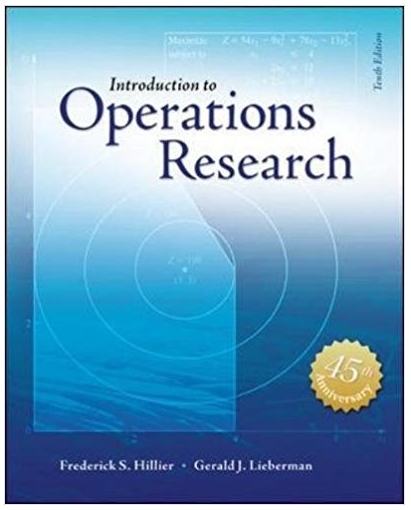Hughs Repair Shop specializes in repairing German and Japanese cars. The shop has two mechanics. One mechanic
Question:
For either kind of car, Hugh would like the expected waiting time in the shop before the repair is completed to be no more than 0.5 day.
(a) Formulate a simulation model for performing a simulation to estimate what the expected waiting time until repair is completed will be next year for either kind of car.
(b) Considering only German cars, use the interactive procedure for simulation in your IOR Tutorial to interactively perform this simulation over a period of 10 arrivals of German cars.
(c) Use the Queueing Simulator to perform this simulation for German cars over a period of 10,000 car arrivals.
(d) Repeat part (c) for Japanese cars.
(e) Hugh is considering hiring a second mechanic who specializes in German cars so that two such cars can be repaired simultaneously. (Only one mechanic works on any one car.) Repeat part (b) for this option.
(f) Use the Queueing Simulator with 10,000 arrivals of German cars to evaluate the option described in part (e).
(g) Another option is to train the two current mechanics to work on either kind of car. This would increase the expected repair time by 10 percent, from 0.2 day to 0.22 day. Use the Queueing Simulator with 20,000 arrivals of cars of either kind to evaluate this option.
(h) Because both the interarrival-time and service-time distributions are exponential, the M/M/1 and M/M/s queueing models introduced in Sec. 17.6 can be used to evaluate all the above options analytically. Use these models to determine W, the expected waiting time until repair is completed, for each of the cases considered in parts (c), (d), ( f ), and (g). (You can either calculate W by hand or use the template for the M/M/s model in the Excel files for Chap. 17.) For each case, compare the estimate of W obtained by simulation with the analytical value. What does this say about the number of car arrivals that should be included in the simulation?
(i) Based on the above results, which option would you select if you were Hugh? Why?
Distribution
The word "distribution" has several meanings in the financial world, most of them pertaining to the payment of assets from a fund, account, or individual security to an investor or beneficiary. Retirement account distributions are among the most...
Fantastic news! We've Found the answer you've been seeking!
Step by Step Answer:
Related Book For 

Introduction to Operations Research
ISBN: 978-1259162985
10th edition
Authors: Frederick S. Hillier, Gerald J. Lieberman
Question Posted:





